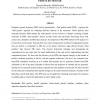Free Online Productivity Tools
i2Speak
i2Symbol
i2OCR
iTex2Img
iWeb2Print
iWeb2Shot
i2Type
iPdf2Split
iPdf2Merge
i2Bopomofo
i2Arabic
i2Style
i2Image
i2PDF
iLatex2Rtf
Sci2ools
CONCURRENCY
2002
2002
Parallel implementation of the fluid particle model for simulating complex fluids in the mesoscale
Dissipative particle dynamics (DPD) and its generalization - fluid particle model (FPM) - represent the "fluid particle" approach for simulating fluid-like behavior in the mesoscale. Unlike particles from molecular dynamics (MD) method, the "fluid particle" can be viewed as a "droplet" consisting of liquid molecules. In FPM, "fluid particles" interact by both central and non-central, short-range forces with conservative, dissipative and Brownian character. In comparison to MD, FPM method in 3-D requires two to three times more memory load and three times more communication overhead. Computational load per step per particle is comparable to MD due to the shorter interaction range allowed between "fluid particles" than between MD atoms. The classical linked-cells technique and decomposing the computational box into strips allow for rapid modifications of the code and for implementing non-cubic computational boxes. We show that the effici...
Related Content
| Added | 18 Dec 2010 |
| Updated | 18 Dec 2010 |
| Type | Journal |
| Year | 2002 |
| Where | CONCURRENCY |
| Authors | Krzysztof Boryczko, Witold Dzwinel, David A. Yuen |
Comments (0)

